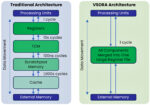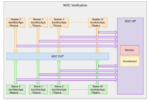You are currently viewing SemiWiki as a guest which gives you limited access to the site. To view blog comments and experience other SemiWiki features you must be a registered member. Registration is fast, simple, and absolutely free so please,
join our community today!
VSORA AI Processor Raises $46 Million to Fast-Track Silicon Development
We stand on the cusp of an era defined by ubiquitous intelligence—a stone’s throw from a tidal wave of AI-powered products underpinned by next-generation silicon. Realizing that future demands nothing less than a fundamental rethink of how we design semiconductors… Read More
When Semidynamics added support for int4 and fp8 data types to their RISC-V processors, it clearly indicated their intent to target AI inference with hundreds or perhaps thousands of concurrent threads running in their advanced caching and pipelining scheme. Two recent announcements around Embedded World 2025 reinforce their… Read More
A Network-on-Chip (NoC) IP addresses the challenges of interconnect complexity in SoCs by significantly reducing wiring congestion and providing a scalable architecture. It allows for efficient communication among numerous initiators and targets with minimal latency and high speed. A NoC facilitates design changes, enabling… Read More
Automotive designs demand a high level of fault tolerance, and one of the methods to achieve this is to use error correcting codes (ECC). This Wikipedia page ECC Memory gives a flavor, though that article concentrates on memory and we are interested in wider applications using a form of forward error correction. This technique … Read More
RISC-V tends to generate excitement over the possibilities for the processor core, any custom instruction extensions, and its attached memory subsystem. Those are all necessary steps to obtaining system-level performance. But is that attention sufficient? Architects who have ventured into larger system-on-chip (SoC) … Read More
While Truechip has established itself as a global provider of verification IP (VIP) solutions, they are always on the lookout for strategic IP needs from their customer base. Over the last several years, a solid market for Network-on-Chip (NoC) IP has grown, driven by the need to rapidly move data across a chip. Concurrently, the… Read More
Driven by the need to rapidly move data across a chip, the NoC IP is already a very common structure for moving data with an SoC. And various implementations of the NoC IP are available in the market depending on the end system requirements. Over the last few years, the RISC-V architecture and the TileLink interface specification … Read More
The reason people love FPGAs for networking and communications applications is because they offer state of the art high speed interfaces and impressive parallel processing power. The problem is that typically a lot of the FPGA fabric resources are used simply to move the data on or off and across the chip. Achronix has cleverly … Read More
Smart network interface cards (SmartNICs) have proven themselves valuable in improving network efficiency. According to Scott Schweitzer, senior product manager at Achronix, it has been shown that SmartNICs can relieve up to – and perhaps beyond – 30% of the host processor’s loading. SmartNICs started out taking… Read More
When we think about Compute and AI SoCs, we often focus on the huge numbers of calculations being carried out every second, and the ingenious IPs that are able to reach such high levels of performance. However, there also exists a significant challenge in keeping the vast quantities of data flowing around the chip which is solved … Read More










